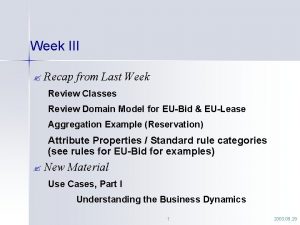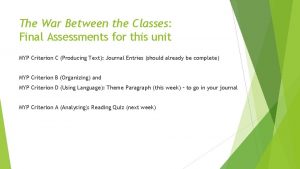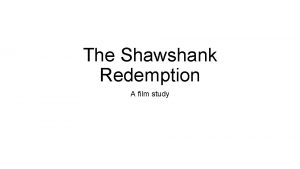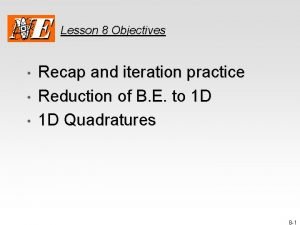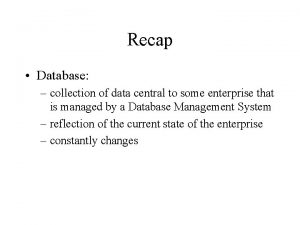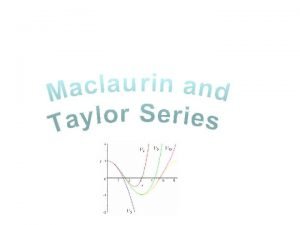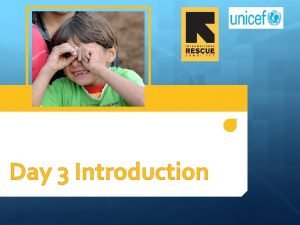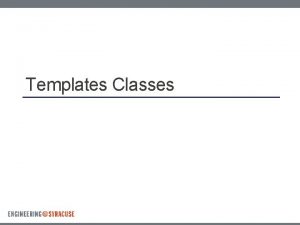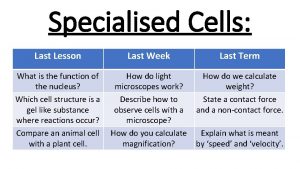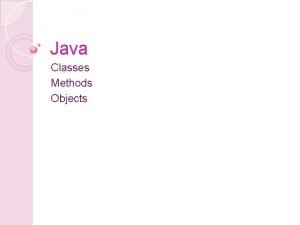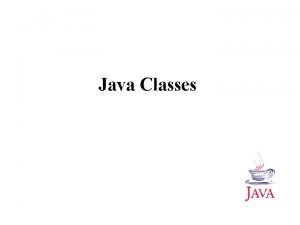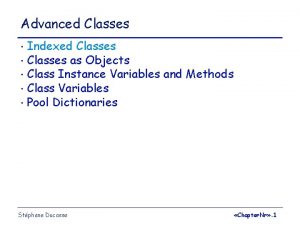Week III Recap from Last Week Review Classes














- Slides: 14

Week III ? Recap from Last Week Review Classes Review Domain Model for EU-Bid & EU-Lease Aggregation Example (Reservation) Attribute Properties / Standard rule categories (see rules for EU-Bid for examples) ? New Material Use Cases, Part I Understanding the Business Dynamics 1 2003. 09. 29

Class models & the development process -- A Class Model defines the static structure of concepts, types, and classes. 3 perspectives we can take when defining a class model: q Conceptual - how users think and talk about the world • • q the software, rather than the business Implementation - class - software component implementation • • ? semantics Specification - type - software component interface • q the terms & facts of the problem space -- the i. e. , the system glossary or domain model typically, business-focused language-specific realization the implementation – "the classes that implement the type" (or, “implement the interface”) ~one type (interface) specification can have multiple implementations. This course deals with the “conceptual” and “specification” perspective class models; the Java course deals with the "implementation" perspective.

Class model diagram elements Class – a description of a set of objects that share the same responsibilities (attributes, relationships, operations, rules) and semantics. q Attributes – the “value facts” the system records the “variables” q Relationships between classes – 3 types: • • • q q association generalization (supertype/subtype) aggregation (“advanced”) Operations – the behavior the "methods" Rules – the constraints that govern both structure (relationships & attributes) and behavior (operations). Many of these elements can be shown visually as a Class Model Diagram.

Association Role properties ~ multiplicity

Associations in perspective q Conceptual • association = "facts" in the users' problem space facts relate concepts, applying terms to form sentences. example: “Customers place orders. ” “Orders may have several order lines. ” q Specification • association = responsibilities an object is "responsible to know" the other objects it is associated with. example: “A customer knows the orders it has placed. ” “An order knows the customer who placed the order. ” q Implementation (e. g. , Java) • association = pointer specifications ("navigability") example: <refer to OOP lecture & also Fowler, p. 54 -56>

Association properties – navigability different treatment for each perspective: q Conceptual – typically left undefined/unannotated • q Specification – directional knowledge • • q knowledge in both directions (bi-directional) is assumed typically drawn without navigation arrowheads Implementation – navigation • ? interpretation is “not applicable”/"undecided" arrowhead means implementation pointer Note: bi-directional navigation implies an additional constraint 1. The two navigations must be inverses of each other. 2. This is true for all three perspectives.

Domain Model Relationships: Generalization / Specialization

Domain Model relationships: Generalization / Specialization (cont) Generalization / Specialization is a feature of OO languages that permits an object's class to be specified as a hierarchy (or network) of classes, ranging from more general classes to very specific classes. • • typically referred to as simply "generalization" also referred to as "supertype / subtype" relationships For example, q Employee • q Relationship Manager and Branch Manager • ? a supertype two, more-specialized types of Employee Subtypes "inherit" responsibilities from the supertype.

Generalization in perspective q Conceptual • generalization = a way of expressing "fact" hierarchies. e. g. , everything we say about an Employee is also true for a Relationship Manager. q Specification • generalization = the interface of a subtype must include all elements from the interface of the supertype. the subtype's interface conforms to the supertype's interface. the principle of ‘substitutability’ applies. q Implementation (e. g. , Java) • generalization = inheritance features in a programming language

Domain Model relationships: Terminology regation • Aggregation Agg Terminology • Aggregation Examples • order + order item --> product • reservation + reservation detail -> reservable item

Domain Model Diagram Elements: rule elements

Class responsibilities: Rules definition A rule is a constraint or condition that limits or guides what an object can "know" or "do. " q Many (structure) rules are expressible using the graphical language. • q e. g. , limiting a relationship to "at most one" or an attribute value to being “mandatory. ” When you need to express a rule that the graphics don't support, state the rule in a “note” or use braces { } surrounding the rule statement. • • write in informal natural language, or use a formal rule language, e. g. , UML's Object Constraint Language (OCL).

Class responsibilities: Rules (cont) ? It is good practice to summarize the Domain Model rules and provide to the stakeholders in a form they can readily review. q Standard rules • • • q initial value rules mandatory value rules unique value rules frozen value rules at-most-one rules [associations] Custom rules that are custom-written to support domain integrity requirements

Class behavior – Operations informal definition: An operation specifies what an object can “do. ” – i. e. , the processes a class knows how to carry out, when requested. example: • • An ATM machine knows how to “accept a deposit. ” A reservation knows how to “close a reservation. ” UML definition: An operation is the specification of a transformation or query that an object may be called on to execute.
 Recap from last week
Recap from last week Hamlet act iii scene ii
Hamlet act iii scene ii Classe e subclasse da palavra esta
Classe e subclasse da palavra esta Pre ap classes vs regular classes
Pre ap classes vs regular classes The war between the classes review
The war between the classes review Resumen de the shawshank redemption
Resumen de the shawshank redemption Gatsby chapter 8 and 9 summary
Gatsby chapter 8 and 9 summary Price matching
Price matching What is the purpose of an iteration recap
What is the purpose of an iteration recap Recap intensity clipping
Recap intensity clipping 60 minutes recap
60 minutes recap Recap database
Recap database Bracket power rule
Bracket power rule Recap introduction
Recap introduction Recap introduction
Recap introduction
